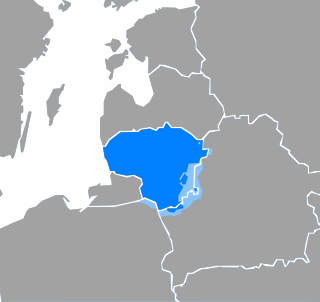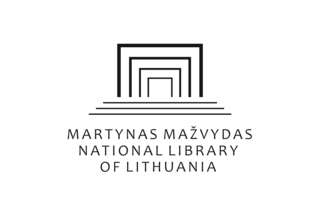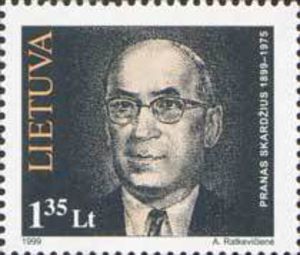
Dictionaries of Lithuanian language have been printed since the first half of the 17th century.

Dictionaries of Lithuanian language have been printed since the first half of the 17th century.
The first Lithuanian language dictionary was compiled by Konstantinas Sirvydas and printed in 1629 as a trilingual (Polish–Latin–Lithuanian) dictionary. Five editions of it were printed until 1713, but it was used and copied by other lexicographers until the 19th century. [1] [2]
The first German–Lithuanian–German dictionary, to address the necessities of Lithuania Minor, was published by Friedrich W. Haack in 1730. [1] A better German–Lithuanian–German dictionary, with a sketch of grammar and history of the language, more words, and systematic orthography, was published by Philipp Ruhig in 1747. [1] In 1800, Christian Gottlieb Mielcke printed an expanded and revised version of Ruhig's dictionary. Its foreword was the last work of Immanuel Kant printed during his life. [3]
There also existed a number of notable unpublished dictionaries.
At the beginning of the 19th century linguists recognized the conservative character of Lithuanian, and it came into the focus of the comparative linguistics of Indo-European languages. To address the needs of linguists, Georg H. F. Nesselmann published a Lithuanian–German dictionary in 1851. [1]
The culmination of Lithuanian linguists' efforts is the 20-volume Academic Dictionary of Lithuanian . [2]


Lithuanian is an East Baltic language belonging to the Baltic branch of the Indo-European language family. It is the official language of Lithuania and one of the official languages of the European Union. There are approximately 2.8 million native Lithuanian speakers in Lithuania and about 1 million speakers elsewhere. Around half a million inhabitants of Lithuania of non-Lithuanian background speak Lithuanian daily as a second language.

Samogitia or Žemaitija is one of the five cultural regions of Lithuania and formerly one of the two core administrative divisions of the Grand Duchy of Lithuania alongside Lithuania proper. Žemaitija is located in northwestern Lithuania. Its largest city is Telšiai, while Šiauliai, where Aukštaitian dialect is being spoken, is sometimes also included into Samogitia. Samogitia has a long and distinct cultural history, reflected in the existence of the Samogitian language.
Lithuanian mythology is the mythology of Lithuanian polytheism, the religion of pre-Christian Lithuanians. Like other Indo-Europeans, ancient Lithuanians maintained a polytheistic mythology and religious structure. In pre-Christian Lithuania, mythology was a part of polytheistic religion; after Christianisation mythology survived mostly in folklore, customs and festive rituals. Lithuanian mythology is very close to the mythology of other Baltic nations – Prussians, Latvians, and is considered a part of Baltic mythology.

Lithuania Minor, or Prussian Lithuania, is a historical ethnographic region of Prussia, where Prussian Lithuanians lived, now located in Lithuania and the Kaliningrad Oblast of Russia. Lithuania Minor encompassed the northeastern part of the region and got its name from the territory's substantial Lithuanian-speaking population. Prior to the invasion of the Teutonic Knights in the 13th century, the main part of the territory later known as Lithuania Minor was inhabited by the tribes of Skalvians and Nadruvians. The land depopulated during the incessant war between Lithuania and the Teutonic Order. The war ended with the Treaty of Melno and the land was repopulated by Lithuanian newcomers, returning refugees, and the remaining indigenous Baltic peoples; the term Lithuania Minor appeared for the first time between 1517 and 1526.

Lithuanian book smugglers or Lithuanian book carriers smuggled Lithuanian language books printed in the Latin alphabet into Lithuanian-speaking areas of the Russian Empire, defying a ban on such materials in force from 1864 to 1904. In Lithuanian knygnešys literally means "the one who carries books". Opposing imperial Russian authorities' efforts to replace the traditional Latin orthography with Cyrillic, and transporting printed matter from as far away as the United States to do so, the book smugglers became a symbol of Lithuanians' resistance to Russification.

The Academic Dictionary of Lithuanian is a comprehensive thesaurus of the Lithuanian language and one of the most extensive lexicographical works in the world. The 20 volumes encompassing 22,000 pages were published between 1941 and 2002 by the Institute of the Lithuanian Language. An online and a CD version was made available in 2005. It contains about 236,000 headwords, or 500,000 if counting sub-headwords, reflecting modern and historical language both from published texts since the first published book in 1547 until 2001 and recorded from the vernacular. Definitions, usage notes, and examples are given for most words. The entry length varies from one sentence to almost a hundred pages. For example, 46 pages are devoted to 298 different meanings of taisyti and its derivatives.

Zigmas Zinkevičius was a Lithuanian academician, baltist, linguist, linguistic historian, dialectologist, politician, and the former Minister of Education and Science of Lithuania (1996–1998). Zinkevičius authored over a hundred books, including the popular six-volume "History of the Lithuanian language" (1984–1994), and over a thousand articles, both in Lithuanian and other languages. He was an academician of the Lithuanian Catholic Academy of Science since 1991 and a full member of the Lithuanian Academy of Sciences from 1990 to 2011, when he became an emeritus member.

Martynas Mažvydas National Library of Lithuania is a national cultural institution which collects, organizes and preserves Lithuania's written cultural heritage content, develops the collection of Lithuanian and foreign documents relevant to research, educational and cultural needs of Lithuania, and provides library information services to the public.

The Lithuanian press ban was a ban on all Lithuanian language publications printed in the Latin alphabet in force from 1865 to 1904 within the Russian Empire, which controlled Lithuania proper at the time. Lithuanian-language publications that used Cyrillic were allowed and even encouraged.

The Prussian Lithuanians, or Lietuvininkai, are Lithuanians, originally Lithuanian language speakers, who formerly inhabited a territory in northeastern East Prussia called Prussian Lithuania, or Lithuania Minor, instead of the Grand Duchy of Lithuania and, later, the Republic of Lithuania. Prussian Lithuanians contributed greatly to the development of written Lithuanian, which for a long time was considerably more widespread and in more literary use in Lithuania Minor than in Lithuania proper.

Martin Ludwig Jedemin Rhesa was a Lutheran pastor and a professor at the University of Königsberg in East Prussia. He is best remembered as publisher of Lithuanian texts. He was the last prominent prominent advocate of the Lithuanian language in Lithuania Minor.

Antanas Juška was a Lithuanian Roman Catholic priest known for his lifelong study of Lithuanian folk traditions. For about three decades, he observed the Lithuanian people, their traditions, and recorded their songs and vocabulary. Juška recorded about 7,000 Lithuanian folk songs, including about 2,000 songs with melodies, and wrote a 70,000-word Lithuanian–Polish dictionary. These works provide a wealth of information of the 19th-century Lithuanian life. His works were partially published with the help of his elder brother Jonas Juška.
The Lithuanian Literary Society was a literary society dedicated to the Lithuanian language that was active from 1879 to about 1923 in Tilsit, East Prussia. It was the first scientific society dedicated to Lithuanian studies. It sought to document, preserve, and study Lithuanian language, folklore, literature, and cultural heritage. Members of the society were mostly non-Lithuanian scholars and conducted its proceedings in German.
Dionizas Poška was a Lithuanian poet, historian and lexicographer sometimes described also as Polish-Lithuanian He contributed to the early 19th-century Samogitian Revival, the early stage of the Lithuanian National Revival. Born to a family of petty Samogitian nobility, Poška attended Kražiai College. From 1786–1821, with some breaks, Poška worked as a lawyer, regent, clerk in the courts of Raseiniai. From 1790, he lived in the purchased Barzdžiai manor.
Draugija was a Lithuanian-language magazine published in Kaunas in 1907–1914, 1919–1923, and 1937–1940. Published by the Society of Saint Casimir, it focused on the issues of Lithuanian culture, literature, science, and politics and was geared towards the intelligentsia and the Catholic clergy. It urged everyone to work on developing the Lithuanian culture which would distinguish the Lithuanian nation from others and believed in slow and steady cultural work. The magazine critically reviewed essentially every more substantial work of Lithuanian literature, published articles to improve and standardize the Lithuanian language, discussed how to improve education, analyzed social and political issues in Lithuania, promoted Christian democracy, criticized ultra-conservatives and attempted to find the proper place for the Catholic Church in modern society and science. Its issues usually had more than 100 pages and reached circulation of 1,000 copies. Its long-term editor was Catholic priest Adomas Jakštas (1907–1938). In total, 213 issues were published. Its supplement for Catholic youth Ateitis (Future) edited by Pranas Dovydaitis gave rise to the Lithuanian Catholic Federation Ateitis.

Eduards Volters was a linguist, ethnographer, archaeologist who studied the Baltic languages and culture. He was a long-time professor at the Saint Petersburg University (1886–1918) and Vytautas Magnus University (1922–1934).

Pranas Skardžius was a Lithuanian linguist. Together with Antanas Salys, Skardžius was the first and most prominent linguist who matured in independent Lithuania.

Friedrich Kurschat was a Prussian Lithuanian linguist and professor at the University of Königsberg. He studied the Lithuanian language and published its grammar in 1876 in which he was the first to describe Lithuanian accentuation in detail.
Adam Friedrich Schimmelpfennig was a Lutheran pastor known for translating and publishing Lithuanian religious texts. He translated sections of the Old Testament and edited the translation of the Bible into Lithuanian. He also edited a Lithuanian hymnal in which he included his own original hymns. He is sometimes nicknamed "the younger" to distinguish him from his uncle (1677–1740) of the same name.